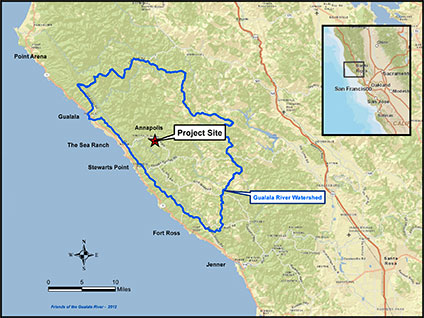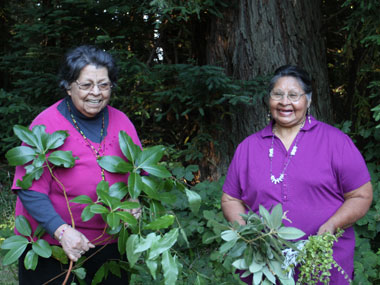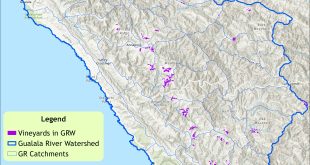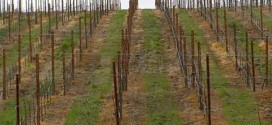Artesa-Sonoma Vineyard Conversion
Sonoma County, California
Destruction of Coastal Redwood Forest
and Pomo Heritage
Redwoods for Red Wine
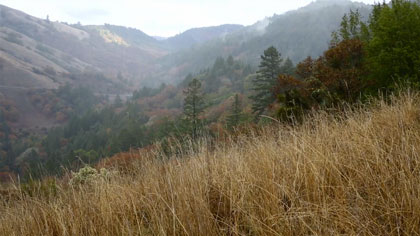
Eight minute video produced for the America Tonight
news broadcast on Al Jazeera America.
Court Rejects Plan to Clearcut Redwoods for Vineyard
 Sonoma County Superior Court rules that the environmental impact report for Artesa’s forest-to-vineyard conversion project violates the requirements of the California Environmental Quality Act. Press Release, December 6, 2013
Sonoma County Superior Court rules that the environmental impact report for Artesa’s forest-to-vineyard conversion project violates the requirements of the California Environmental Quality Act. Press Release, December 6, 2013
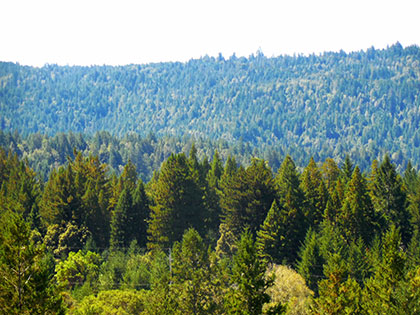
Artesa’s property in foreground, forested ridges in background.
Artesa Vineyards and Winery, owned by Spanish wine corporate giant Codorníu, is now the only California vineyard developer applying for permits to clear-cut coastal redwood forest and grade the soils to construct a sprawling vineyard, roads, and reservoirs in their place.
Controversy
Sonoma County Superior Court has rejected Artesa’s environmental impact report. Despite widespread public outcry, Artesa has not withdrawn their application. Instead, they claim that the public is misinformed.
Artesa claims that there is no forest on their property. Take a look at these photos, and decide for yourself. Artesa wants to correct the supposed newspaper mis-statements that they plan to clear-cut old growth redwood trees, but we can’t find ANY articles that say that. We’re opposed to their plan to destroy redwood forest.
Artesa says their vineyard development site is not culturally significant and has no important cultural or archaeological impacts. Kashaya Pomo elders have a different perspective. Peter Schmidt, Professor of Anthropology and Archaeology, is concerned that Artesa’s project threatens key heritage sites that are critical to the cultural well-being of Native peoples. Eric Wilder, grandson of Kashaya tribal spiritual leader Essie Parrish and former tribal chair, says that, “our people will always be a part of this land.”
Summary
The 173 acre Artesa-Sonoma vineyard project in Annapolis, remote northwestern Sonoma County, was authorized by CAL FIRE in 2012 to proceed with deforestation of the project site that lies within a rich and unique archaeological complex of Pomo village and camp sites.
Only a lawsuit over the final Environmental Impact Report (EIR) for the project, filed by Friends of the Gualala River, Sierra Club, and Center for Biological Diversity, is currently (2013) delaying the clear-cutting.
Since the permit process for the 20,000 acre Preservation Ranch development (over 1600 acres of vineyards) was withdrawn earlier in 2013, the Artesa-Sonoma project is the only forest-to-vineyard conversion project poised to proceed in California. If Artesa Vineyards does not voluntarily withdraw the project under public protest, it will open the door to innumerable permits to clear-cut coastal California forests for more vineyards. The EIR lawsuit is only a temporary barrier to the project’s implementation.
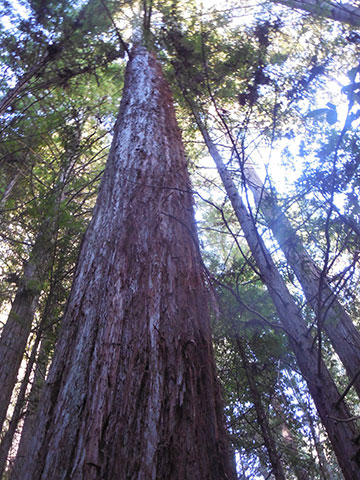
Large redwood on Artesa’s property in northwestern Sonoma County.
The environmental impacts of the project itself would be severe, and so is the permit precedent for proliferation of Artesa-like vineyard deforestation projects. The grading of the project would clear-cut 154 acres of mixed redwood and Douglas-fir forest that is regenerating from devastation of the unregulated post-war tractor logging era. It would grade away the soils that supported Native American inhabitants for at least seven thousand years, reducing “cultural preservation” to a mockery of fenced-off individual artifact locations in a matrix of vineyard rows.

Clear-cutting redwood forest to plant a vineyard
The Tribal Council of the Kashia Band of Pomo Indians of the Stewarts Point Rancheria is on record as opposing the project because it threatens “…our watershed, forests, sacred sites, and tribal archeological sites and cultural resources that are of cultural and religious significance to the Tribe.”
 “The idea that these sacred places could be fenced off is not good. We don’t go for that. You don’t have to dig it up. “The idea that these sacred places could be fenced off is not good. We don’t go for that. You don’t have to dig it up.  We know that whole area is a village site. All these places were occupied and used by our people.”- Violet Parrish Chappell and Vivian Parrish Wilder We know that whole area is a village site. All these places were occupied and used by our people.”- Violet Parrish Chappell and Vivian Parrish WilderPomo elders speak out about vineyards October, 2010, Sonoma County Gazette |
Dr. Peter Schmidt, Professor of Anthropology and Archeology, stated in 2010 that “…recent destruction of these Native American settlements and other sites has occurred as a consequence of vineyard development that necessitates the ripping of soils with bulldozers equipped with vertical forks that penetrate deeply to destroy ancient sites, permanently removing any knowledge of the past.”
 “This is OUR land; a blessed and sacred forest and no one can take that from us. The spirits of our ancestors are upon us in this forest because the place is alive. “This is OUR land; a blessed and sacred forest and no one can take that from us. The spirits of our ancestors are upon us in this forest because the place is alive.  How can anyone put the value of a bottle of wine above the value of my people?”- Kashia Pomo youth, quoted in the February 24, 2012 issue of the Independent Coast Observer How can anyone put the value of a bottle of wine above the value of my people?”- Kashia Pomo youth, quoted in the February 24, 2012 issue of the Independent Coast Observer |
The biological impacts of the project are cumulative over time. Routine annual applications of herbicides and pesticides would become the new norm for the local Patchett Creek watershed that drains to the Gualala River, adding to the load from vineyard sprawl that erupted over a decade ago, following Kendall-Jackson’s groundbreaking large vineyard development further east along Annapolis Road.
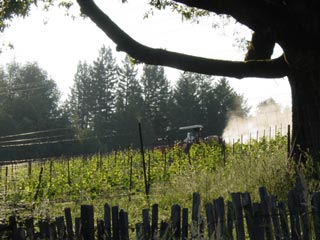
Pesticide application on Annapolis vineyard
The vineyard will capture rainwater runoff in reservoirs for irrigation and develop unregulated wells to tap groundwater. When challenged that vineyard well pumping would significantly impact groundwater that sustains the river and its fish and wildlife, Artesa incredibly declared that the unregulated well water would be used for “domestic use” only, and not vineyard irrigation and frost protection!
Replicated over the Sonoma and Mendocino coast landscape, permitting of this Artesa-Sonoma project would result in a checkerboard of permanent clear-cuts in coastal forestland as more international financial investment fuels a new generation of Artesa-type projects.
Public opposition to the project has been intense and sustained. Over 93,000 people signed a petition opposing the Artesa and Preservation Ranch projects.
Even more alarming for the Spanish corporation (Codorníu) promoting the project, over 37,000 Spaniards signed a petition asking Codorníu “not to destroy forests to produce their wines.”
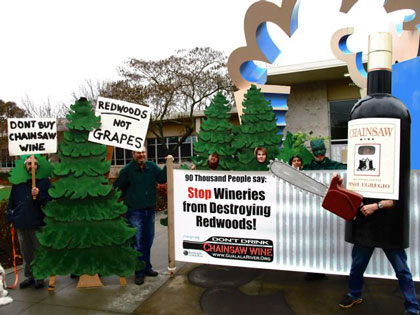
Friends of the Gualala River and supporters present the Sonoma County Board of Supervisors with an 18 foot long copy of a petition with over 90,000 signatures opposing the giant redwood forest destroying vineyard conversion projects, Preservation Ranch and Artesa Sonoma.
Neither Codorníu nor Artesa made any reply to the petitions, other than issuing a bizarre denial that there were no more than a few redwood trees left on the property! Artesa either willfully deceived the public, or was ignorant that redwoods regenerate and mature after falling….unless the stumps and soils are graded away, which is exactly what Artesa plans to do.
The Artesa-Sonoma project history follows a similar path of unbridled speculation in vineyard development that spawned, and later finished, Preservation Ranch.
  “I don’t see a need for more deforestation to have a great wine economy, because there is a lot of cleared land already available.” – Adina Merelender, UC Berkeley conservation biologist, quoted in Redwoods versus red wine – LA Times “I don’t see a need for more deforestation to have a great wine economy, because there is a lot of cleared land already available.” – Adina Merelender, UC Berkeley conservation biologist, quoted in Redwoods versus red wine – LA Times |
In 2001, as the peak of the premium California wine market bubble was approaching, Artesa Napa vineyards submitted permit application to the California Department of Forestry and Fire Protection (now CAL FIRE) to clear-cut 105 acres of redwood forest in Annapolis, Sonoma County — a smaller area than the later Environmental Impact Report proposed (171 acres) and what Artesa currently proposes (154 acres).
Neither Artesa nor CAL FIRE conducted any serious environmental review of the initial proposal: they completed a cursory environmental checklist with boxes for existing cultural and environmental impacts — all checked “no,” without explanation — including a box for impacts to Native American archeological and cultural resources.

Long-axis views up the trunks to crowns.
CAL FIRE and Artesa were forced to prepare an EIR for the project after Friends of the Gualala River and Sierra Club successfully sued CAL FIRE on several other local Annapolis vineyard conversions that were being permitted without EIRs.
In 2004, Artesa withdrew the 105 acre permit application and replaced it with a larger 171 acre project for review under an EIR, even though the purpose of the California Environmental Quality Act (CEQA) is to minimize impacts to the environment. Artesa never explained the reason for increasing the project size by almost a third of the original size. Then the Artesa EIR process mysteriously left public sight for over four years.
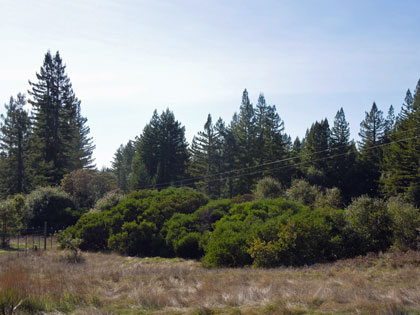
Redwood, manzanita and meadows at the fenced east end of the Artesa-Sonoma property in Annapolis, 2012, viewed from public road access.
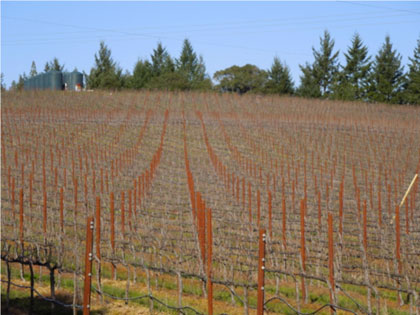
The Artesa-Sonoma project would convert ancient Pomo redwood forest, meadow, and manzanita groves into a permanent clear-cut biological desert of industrial agriculture, with water-demanding, herbicide-‘mowed’ vineyard rows like this one.
In 2009, the Draft Environmental Report (EIR) for Artesa was released by CAL FIRE. Its defects were so severe that even Artesa and CAL FIRE decided to recirculate a new draft version of the EIR, focusing on defending the failure of the first draft EIR to deal with impacts to Native American heritage (archaeology and cultural resources) and climate change / greenhouse gas emissions.
The revised draft EIR was released in 2011, failing to make any substantial corrections to the significant environmental impacts that were grossly underestimated or glossed over in the original draft EIR. CAL FIRE approved the final EIR in May 2012 and gave notice that it would approve the project.
Codorníu and Artesa-Sonoma have ignored the 93,000 signature on-line petition against this project, and they have ignored the fate of Preservation Ranch, and what its demise indicates about public outrage over deforestation for premium wine.
A second wave of public protest — in social media, news media, online, and political — is building, now that the court has ruled that the Artesa-Sonoma EIR violates the requirements of the California Environmental Quality Act.
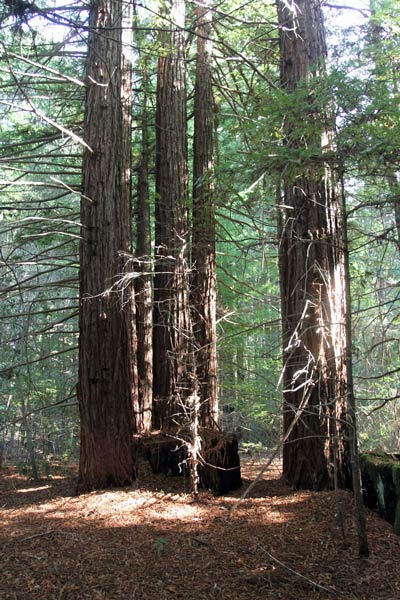
Redwood forest on the Artesa property in Annapolis, CA
For additional information, see:
 Redwoods for Red Wine
Redwoods for Red Wine
Eight minute video produced for the
America Tonight news broadcast on
Al Jazeera America.
Aerial views of the Artesa Sonoma property
 A fly-over of the Artesa Winery / Codorniu proposed vineyard area. Sonoma County Superior Court has rejected the environmental impact report for the project, but Artesa has not withdrawn the application despite widespread public outcry.
A fly-over of the Artesa Winery / Codorniu proposed vineyard area. Sonoma County Superior Court has rejected the environmental impact report for the project, but Artesa has not withdrawn the application despite widespread public outcry.
Interview with Friends of the Gualala River
 Several members of FoGR are interviewed by award winning radio producer Peggy Berryhill on KGUA 88.3 FM. Topics include the proposed Artesa Winery vineyard conversion, and the recent court ruling rejecting Artesa’s environmental impact report.
Several members of FoGR are interviewed by award winning radio producer Peggy Berryhill on KGUA 88.3 FM. Topics include the proposed Artesa Winery vineyard conversion, and the recent court ruling rejecting Artesa’s environmental impact report.
January, 2014, KGUA Radio
Judge rejects vineyard’s environmental impact statement
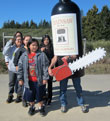 Sonoma County Superior Court Judge Elliot Daum has sent a plan to clearcut 154 acres of forest near Annapolis back to the drawing board, saying the Environmental Impact Report prepared by Cal Fire violates California law in several important aspects.
Sonoma County Superior Court Judge Elliot Daum has sent a plan to clearcut 154 acres of forest near Annapolis back to the drawing board, saying the Environmental Impact Report prepared by Cal Fire violates California law in several important aspects.
December, 2013, Independent Coast Observer
Court Blocks Sonoma Vineyard Planting
 The battle over more than 300 acres of undeveloped land on Sonoma’s coast owned by Artesa Vineyards and Winery isn’t over, but environmental groups have won a key round. A county judge has rejected several parts of Artesa’s environmental review of plans to plant vineyards on the property, blocking development of the site for now. December, 2013, Wine Spectator
The battle over more than 300 acres of undeveloped land on Sonoma’s coast owned by Artesa Vineyards and Winery isn’t over, but environmental groups have won a key round. A county judge has rejected several parts of Artesa’s environmental review of plans to plant vineyards on the property, blocking development of the site for now. December, 2013, Wine Spectator
Ruling deals setback to Artesa’s disputed vineyard plan
 Environmentalists are hailing a court ruling this week that deals a significant setback to a hotly disputed vineyard project in northwestern Sonoma County. If it stands, the decision could serve as a bulwark against the push of vineyards into a mostly untilled swath of the region’s coast range. December, 2013, Santa Rosa Press Democrat
Environmentalists are hailing a court ruling this week that deals a significant setback to a hotly disputed vineyard project in northwestern Sonoma County. If it stands, the decision could serve as a bulwark against the push of vineyards into a mostly untilled swath of the region’s coast range. December, 2013, Santa Rosa Press Democrat
 Court Rejects Plan to Clearcut Redwoods for Vineyard
Court Rejects Plan to Clearcut Redwoods for Vineyard
Sonoma County Superior Court rules that the environmental impact report for Artesa’s forest-to-vineyard conversion project violates the requirements of the California Environmental Quality Act. Press Release, December 6, 2013
 Forest, or not a forest? You decide.
Forest, or not a forest? You decide.
Artesa says there is no forest on their property. Take a look at these photos, and decide for yourself.
 Don’t destroy redwood forest for vineyards – and – Protect CA redwood forests from winery development
Don’t destroy redwood forest for vineyards – and – Protect CA redwood forests from winery development
Over 47,000 people signed petitions urging Artesa to STOP their planned destruction of redwood forest to plant a vineyard in the fall of 2013.
Who do you trust?
 Who do you believe about Pomo Indian heritage protection? Vineyard developer Artesa, or traditional Pomo elders and a Professor of Archaeology and Anthropology with expertise on Kashaya Pomo?
Who do you believe about Pomo Indian heritage protection? Vineyard developer Artesa, or traditional Pomo elders and a Professor of Archaeology and Anthropology with expertise on Kashaya Pomo?
 Eric Wilder and Starhawk speak
Eric Wilder and Starhawk speak
at “Wine Back Into Water” event
Excerpts from speeches by Eric Wilder and Starhawk at Annapolis Winery on August 24, 2013.
Fight over vineyards pits redwoods against red wine
 In the California wine mecca of Sonoma County, climate change is pitting redwood lovers against red wine lovers. This Friday morning, a coalition of environmental groups are in a Santa Rosa, Calif., courtroom fighting to stop a Spanish-owned winery from leveling 154 acres of coast redwoods and Douglas firs to make way for grapevines.
In the California wine mecca of Sonoma County, climate change is pitting redwood lovers against red wine lovers. This Friday morning, a coalition of environmental groups are in a Santa Rosa, Calif., courtroom fighting to stop a Spanish-owned winery from leveling 154 acres of coast redwoods and Douglas firs to make way for grapevines.
October, 2013, National Public Radio
Misinformation?
 Friends of the Gualala River has opposed Artesa’s plan to clearcut forestland to plant a vineyard for a decade. We encourage the public to read our comments, read Artesa’s comments, and come to your own conclusions.
Friends of the Gualala River has opposed Artesa’s plan to clearcut forestland to plant a vineyard for a decade. We encourage the public to read our comments, read Artesa’s comments, and come to your own conclusions.
 Redwood Chapter defends coastal forest
Redwood Chapter defends coastal forest
We think the highest and best use of coastal forests is to remain in their natural condition so they can protect our coastal rivers, support fish and wildlife, and combat climate change by sequestering carbon.
November, 2013, Redwood Chapter Sierra Club
Codorníu contra las secuoyas de California
 Imagínate mi gran disgusto cuando me enteré de que una empresa española, Codorníu, quiere talar más de 62 hectáreas de bosque de secuoyas del río Gualala en el pueblo de Annapolis, California, para plantar viñedos.
Imagínate mi gran disgusto cuando me enteré de que una empresa española, Codorníu, quiere talar más de 62 hectáreas de bosque de secuoyas del río Gualala en el pueblo de Annapolis, California, para plantar viñedos.
November, 2013, El Huffington Post (Spain)
El ‘vino de motosierra’ de Codorníu
 Puede que de forma ingenua el vino se asocie al amor por la tierra y al entendimiento con la naturaleza… Lo que no aparece en tu mente, desde luego, son imágenes de motosierras talando árboles y excavadoras arrancando sus raíces para plantar viñedos.
Puede que de forma ingenua el vino se asocie al amor por la tierra y al entendimiento con la naturaleza… Lo que no aparece en tu mente, desde luego, son imágenes de motosierras talando árboles y excavadoras arrancando sus raíces para plantar viñedos.
October, 2013, El País (Spain)
Redwoods or Red Wine: Which is More Valuable in California?
 When do trees become a forest? According to a California winemaker who wants to clear cut 154 acres of redwoods and Douglas firs to make way for grapevines, not until they’re more than 50-years-old and 100 feet tall.
When do trees become a forest? According to a California winemaker who wants to clear cut 154 acres of redwoods and Douglas firs to make way for grapevines, not until they’re more than 50-years-old and 100 feet tall.
October, 2013, Care2
Chainsaw Wine
 There is no forest among the trees. That’s what state officials have said regarding a large stand of second-growth redwood and Douglas fir near Annapolis that a Spanish-owned winery has proposed to level and replace with grapevines.
There is no forest among the trees. That’s what state officials have said regarding a large stand of second-growth redwood and Douglas fir near Annapolis that a Spanish-owned winery has proposed to level and replace with grapevines.
October, 2013, North Bay Bohemian
Video: Clearcutting redwoods and destroying a Native American site
 Chris Poehlmann, president of Friends of the Gualala River, talks about Artesa’s and parent company Codorniu’s plan to clearcut California redwoods and destroy a Native American Pomo site.
Chris Poehlmann, president of Friends of the Gualala River, talks about Artesa’s and parent company Codorniu’s plan to clearcut California redwoods and destroy a Native American Pomo site.
Video: Moving speech about land to be bulldozed for vineyard
 Kashaya Pomo Eric Wilder gives a moving speech about the tribe’s historical land that is set to be bulldozed for a vineyard owned by the Spanish company Codorniu.
Kashaya Pomo Eric Wilder gives a moving speech about the tribe’s historical land that is set to be bulldozed for a vineyard owned by the Spanish company Codorniu.
Video: Starhawk speaks about proposed Artesa Winery deforestation
 Starhawk is author of many works celebrating the Goddess movement and Earth-based, feminist spirituality. She is a peace, environmental, and global justice activist and trainer, a permaculture designer and teacher, a Pagan and Witch.
Starhawk is author of many works celebrating the Goddess movement and Earth-based, feminist spirituality. She is a peace, environmental, and global justice activist and trainer, a permaculture designer and teacher, a Pagan and Witch.
Video: Starhawk: Nurturing the land or extracting profit?
 Another excerpt of Starhawk‘s talk in Annapolis, contrasting the way the Pomo lived on the land with the plans of the giant corporation, Codorniu (which owns Artesa Winery), to extract profit from the land.
Another excerpt of Starhawk‘s talk in Annapolis, contrasting the way the Pomo lived on the land with the plans of the giant corporation, Codorniu (which owns Artesa Winery), to extract profit from the land.
Starhawk: Redwoods are the cathedrals of this land
 Third excerpt of Starhawk‘s talk in Annapolis, emphasizing the uniqueness of the redwood ecosystem, our need to learn to live in harmony with the land, and to cherish the wild places.
Third excerpt of Starhawk‘s talk in Annapolis, emphasizing the uniqueness of the redwood ecosystem, our need to learn to live in harmony with the land, and to cherish the wild places.
 Changing Wine Back Into Water
Changing Wine Back Into Water
At a recent Friends of the Gualala River event, we satirically change Artesa wine back into water and put it back into the ground from which it came.
Video: Water plant operator talks about Artesa’s proposed vineyard project
 Paul Chappell, California Certified Water Plant Operator for the Kashaya band of Pomo Indians, speaks about Artesa and their plan to clear cut over 150 acres of redwoods to put in vineyards.
Paul Chappell, California Certified Water Plant Operator for the Kashaya band of Pomo Indians, speaks about Artesa and their plan to clear cut over 150 acres of redwoods to put in vineyards.
Video: Interview with resident of Annapolis asking Artesa to stop!
 Annapolis resident Nancy Dew talks about Artesa Winery, which has permits in place right now to clear-cut coastal redwoods and put in a vineyard that would share a border with her property and destroy her water supply.
Annapolis resident Nancy Dew talks about Artesa Winery, which has permits in place right now to clear-cut coastal redwoods and put in a vineyard that would share a border with her property and destroy her water supply.
 Audio: Turning Wine into Water
Audio: Turning Wine into Water
KGUA Radio’s Peggy Berryhill reports on Friends of the Gualala River’s August event, “Gualala River Alchemy: Turning Wine into Water,” followed by an interview with Dave Jordan, recorded on October 24, 2013.
Lawsuit Filed to Stop Clearcutting of Redwoods
 for Sonoma County Vineyard
for Sonoma County Vineyard
Conservation groups filed a lawsuit today challenging a controversial proposal by a Spanish corporation to clearcut 154 acres of redwood forest to plant wine grapes in northwestern Sonoma County. Press Release, June 7, 2012
Petition filed in Sonoma County Superior Court
 We find legal fault with Codorníu/Artesa’s “Fairfax” Conversion Project EIR on numerous grounds, including but not limited to its analysis of alternatives, water quality impacts, cultural resources, environmental setting, noise and greenhouse gases, and request the Court to set aside Cal-Fire’s approval of the project and its timberland conversion permit, as well as certification of its EIR.
We find legal fault with Codorníu/Artesa’s “Fairfax” Conversion Project EIR on numerous grounds, including but not limited to its analysis of alternatives, water quality impacts, cultural resources, environmental setting, noise and greenhouse gases, and request the Court to set aside Cal-Fire’s approval of the project and its timberland conversion permit, as well as certification of its EIR.
Opponents file lawsuits over Artesa vineyard project
 “Three environmental groups sued the state and a Spanish wine conglomerate on Thursday over approval of a hotly disputed vineyard project in northwest Sonoma County.”
“Three environmental groups sued the state and a Spanish wine conglomerate on Thursday over approval of a hotly disputed vineyard project in northwest Sonoma County.”
June 7, 2012, Santa Rosa Press Democrat
 A Giant Step
A Giant Step
Friends of the Gualala River (FoGR) has taken a giant step to stop vineyard projects that clearcut the river’s forest, and we need your help! This is your opportunity to make a difference right in your own “back yard.”
 Issues summary: Artesa Annapolis forest conversion to vineyards
Issues summary: Artesa Annapolis forest conversion to vineyards
A short summary of some of the reason we are opposed to Artesa Vineyards & Winery’s plan to clearcut redwood forest near Annapolis to plant grapes.
Environmental Impact Report for the
|
 State approves Artesa forest-to-vineyard project in Annapolis
State approves Artesa forest-to-vineyard project in Annapolis
“State forestry officials… approved a controversial timber-to-vineyard conversion project in northwest Sonoma County, following through with a decision expected months ago.”
May 8, 2012, Press Democrat
What price one more bottle of wine?
 Recently, when I stepped out of our chapel, the sun had just risen. A piercing cry of a mountain lion came out of the redwood trees that may soon be cut down. Probably the lion was only looking for a mate, as his ancestors have been doing for centuries. But as our neighbor, a Kashia Pomo spiritual elder, said to me a few weeks back about a similar situation, “He is crying over the loss of his home.”
Recently, when I stepped out of our chapel, the sun had just risen. A piercing cry of a mountain lion came out of the redwood trees that may soon be cut down. Probably the lion was only looking for a mate, as his ancestors have been doing for centuries. But as our neighbor, a Kashia Pomo spiritual elder, said to me a few weeks back about a similar situation, “He is crying over the loss of his home.”
Brother Tolbert McCarroll, Starcross Monastic Community
 Artesa’s Hired Gun
Artesa’s Hired Gun
“Rarely has any North Coast wine industry entity received so much negative attention, this being an industry that carefully identifies itself with the trope of enlightened small farmers in bucolic settings living in harmony with the land.”
May, 2012, Anderson Valley Advertiser
FoGR asks Codorníu to withdraw their proposal
 Friends of the Gualala River again asks Codorníu of Barcelona, Spain, to withdraw its controversial Artesa Sonoma proposal to clear-cut ~150 acres of coastal redwood forest for new vineyards to produce wine grapes. April 2012, FoGR
Friends of the Gualala River again asks Codorníu of Barcelona, Spain, to withdraw its controversial Artesa Sonoma proposal to clear-cut ~150 acres of coastal redwood forest for new vineyards to produce wine grapes. April 2012, FoGR
 Artesa: Clear-cut old growth redwood trees or destroying redwood forest?
Artesa: Clear-cut old growth redwood trees or destroying redwood forest?
Artesa wants to correct the supposed newspaper mis-statements that they plan to clear-cut old growth redwood trees, but we can’t find ANY articles that say that. We’re opposed to their plan to destroy redwood forest.
Interview with Friends of the Gualala River
 Several members of FoGR are interviewed by award winning radio producer Peggy Berryhill on KGUA 88.3 FM. Topics include the proposed “Preservation” Ranch and Artesa Winery vineyard conversions.
Several members of FoGR are interviewed by award winning radio producer Peggy Berryhill on KGUA 88.3 FM. Topics include the proposed “Preservation” Ranch and Artesa Winery vineyard conversions.
February, 2012, KGUA Radio
 Artesa’s controversial timber-to-vineyard plan nears approval
Artesa’s controversial timber-to-vineyard plan nears approval
“A project that would clear up to 146 acres of forest for vineyards in northwest Sonoma County is nearing state approval.”
February, 2012, Santa Rosa Press Democrat
Stop clear-cutting redwoods to plant vineyards
 More than 2,600 people petitioned the California Department of Forestry (CAL FIRE) to suspend certification of Artesa Winery‘s Final Environmental Impact Report and allow public comment on relevant changes in circumstances and impacts in the spring of 2012.
More than 2,600 people petitioned the California Department of Forestry (CAL FIRE) to suspend certification of Artesa Winery‘s Final Environmental Impact Report and allow public comment on relevant changes in circumstances and impacts in the spring of 2012.
Stop Wineries from Destroying Redwoods
Protest at Board of Supervisors meeting
 Friends of the Gualala River and supporters presented the Sonoma County Board of Supervisors with an 18 foot long copy of a petition with over 90,000 signatures opposing the giant redwood forest destroying vineyard conversion projects, Preservation Ranch and Artesa Winery / Annapolis.
Friends of the Gualala River and supporters presented the Sonoma County Board of Supervisors with an 18 foot long copy of a petition with over 90,000 signatures opposing the giant redwood forest destroying vineyard conversion projects, Preservation Ranch and Artesa Winery / Annapolis.
 Into the Woods
Into the Woods
“Two proposed vineyard projects in remote areas of Sonoma County are drawing the ire of neighbors and environmentalists — but can winegrapes preserve a redwood forest?” December, 2011, North Bay Biz
Codorníu’s statement & our response
 Following a tidal wave of negative publicity (over 125,000 signatures on petitions opposing their project), Codorníu issues a statement defending their project, and Friends of the Gualala River responds.
Following a tidal wave of negative publicity (over 125,000 signatures on petitions opposing their project), Codorníu issues a statement defending their project, and Friends of the Gualala River responds.
 Artesa Vineyards & Winery
Artesa Vineyards & Winery
Artesa’s Facebook page has a description of their vineyard “conversion” project in Annapolis, but it doesn’t match what they say in their draft Environmental Impact Report.
Petition opposing destruction of redwood forests
 Over 93,000 people signed a petition in the fall of 2011 encouraging elected officials to help us stop Codorniu’s Artesa Napa Winery and Premier Pacific Vineyards from destroying coastal redwood forest and Native American heritage for financial gain.
Over 93,000 people signed a petition in the fall of 2011 encouraging elected officials to help us stop Codorniu’s Artesa Napa Winery and Premier Pacific Vineyards from destroying coastal redwood forest and Native American heritage for financial gain.
“Pídele a Codorníu que no destruya
los bosques para producir sus vinos”
 [Ask Codorníu not to destroy
[Ask Codorníu not to destroy
forests to produce their wines]
Over 37,000 people signed a petition on Spanish website Actuable in the fall of 2011 asking Codorníu [based in Spain] not to destroy redwood forest in Sonoma County to produce their wines.
The Mendonoma Coast’s Second Spanish Invasion
 Spanish wine corporation Grupo Codorníu is accustomed to doing things in a big way. It is reputed to own a greater expanse of vineyard acreage than any wine company in Spain, which in turn has more land under grapevine cultivation than any nation in the world.
Spanish wine corporation Grupo Codorníu is accustomed to doing things in a big way. It is reputed to own a greater expanse of vineyard acreage than any wine company in Spain, which in turn has more land under grapevine cultivation than any nation in the world.
June, 2011, Anderson Valley Advertiser
Gualala vineyard conversions get national attention
 June, 2011: “Plan to cut forest for vineyards faces opposition”, an article by the Associated Press, appears in newspapers across the country, including the San Francisco Chronicle, Washington Post, Sacramento Bee, etc., as well as Salon, Huffington Post, Forbes and many others.
June, 2011: “Plan to cut forest for vineyards faces opposition”, an article by the Associated Press, appears in newspapers across the country, including the San Francisco Chronicle, Washington Post, Sacramento Bee, etc., as well as Salon, Huffington Post, Forbes and many others.
Coalition asks Spanish corporation to withdraw proposal to clear-cut coastal redwood forest for vineyards
 Friends of the Gualala River has joined with 18 national, California, and regional environmental organizations in asking the international wine corporation, Codorníu of Barcelona, Spain, to withdraw its controversial proposal to destroy nearly 150 acres of coastal redwood forest by clear-cutting and converting the area for new vineyards to produce premier wine grapes.
Friends of the Gualala River has joined with 18 national, California, and regional environmental organizations in asking the international wine corporation, Codorníu of Barcelona, Spain, to withdraw its controversial proposal to destroy nearly 150 acres of coastal redwood forest by clear-cutting and converting the area for new vineyards to produce premier wine grapes.
 Pomo heritage threatened
Pomo heritage threatened
The Artesa vineyard project area is “very possibly the Kashaya Pomo village Kabatui” where “human remains may be present,” and which contains rich archaeological areas that are eligible for listing in the National Registry of Historic Places.
Pomo elders speak out about vineyards
 Where we used to live, no one can see anything now. It is time we open our mouths. Those vineyard people are interfering with our ancestors’ area…
Where we used to live, no one can see anything now. It is time we open our mouths. Those vineyard people are interfering with our ancestors’ area…
 Erasing Native American history?
Erasing Native American history?
As an early morning mist filters through the Redwoods in the village of Annapolis in NW Sonoma County, a Pomo elder of the Kashia band walks through the forest toward an ancient settlement site…
 Artesa (“Fairfax”) vineyard conversion history Information about the history of this proposed conversion.
Artesa (“Fairfax”) vineyard conversion history Information about the history of this proposed conversion.
 Friends of Gualala River Protecting the Gualala River watershed and the species living within it
Friends of Gualala River Protecting the Gualala River watershed and the species living within it
